Note: I hadn’t intended this to be an early part of the Raising Chickens series I’m doing, as it is way out of sync of the order one might ideally present such a series in. But… It’s Winter! (Needs to go up, now.)
The location of my hen house is perfect for most the months of the year, but in Winter it can be a bit of a challenge to tread to, here in the northerly snows of Zone 5 B. In fact, that snow that came mid-November through the northeast never totally removed itself until the 23rd of December… a feat that lasted about two days before more came. Fortunately just a little for a while.
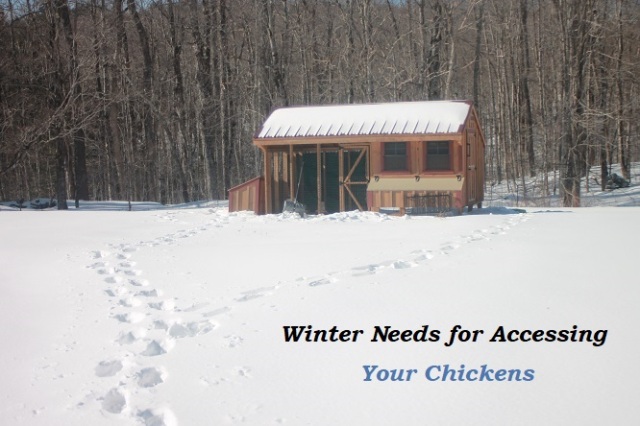
I had certain constraints when laying down the location for the hen house and run: the hen house, coop and run had to be on a flat surface, reasonably close to the solar panels — the coop WILL BE connected to electric come spring. (Things just froze up outside sooner than I was able to do what I shoulda done, and the landscapers with the excavator got involved here late, and ran out of time…) The set up had to be in the back yard, just for aesthetics. (Although I enjoy running chickens enough that if I set up a second coop, that will be in the front of the house, to the side, and I can plant shrubbery around the road side. Plus I didn’t know I’d be getting such an attractive coop.) I also didn’t want them too close to the human entertainment area which will be set up as a patio with a smoker grill, fire pit, and Maypole. Chickens aren’t exactly continent. The solar panels had to be closer to the house (the longer you run the line, the higher the price).
So… my birds are way out there in the back, which feels just right in the summer but not so all-right in winter with a layer of snow. And, snow which varies in texture and walkability with type of snow, or ack, ICE! There’s a slight downhill slope at one point, too. So, let’s say it’s about 350 feet from my back door to the coop, since I can’t walk it in a straight line, such as a crow allegedly flies.
So, this one year, sans electric at the coop, but still having Winter, me being 65 years old, with some relatively minor but long-term physical issues, this is how I cope:
*Note*: for me this for 12 chickens, located around 350 feet as the crow won’t fly, from my back door. Scale up or down as required.
Hiking Poles. I have two non-optimal knees, and one bad ankle. There is a slight slope in one location on the way down. I bought my first pair of hiking poles from LL Bean, and they were very useful for various purposes over this past year. However, one pole did snap in half not long ago. (Since I have a disjointed sense of humor, I’ve left the bottom part of that pole remaining out there. For now, anyway.)
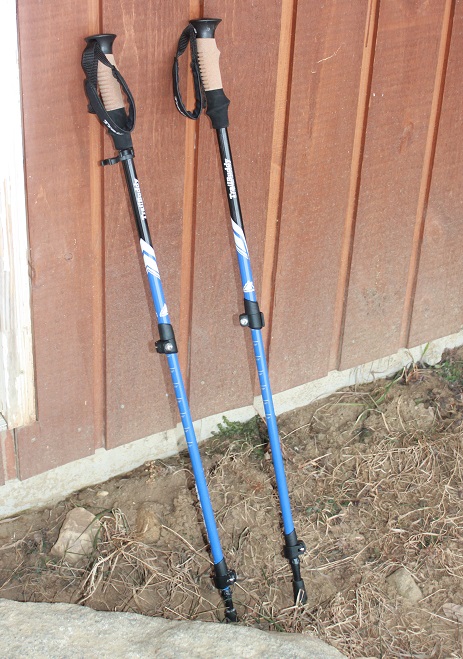
The new hiking poles. Sized up and ready for use.
SO, I bought a second pair. I will note that I usually manage well using just one pole, and it strictly depends on the type of snow/ice or how/where I want to hike, if I really need both. (Or, either.) Backups, however… one cannot say too much about back ups, whether on hiking equipment or on computer dalliances. Anyhow, the second pair: TrailBuddy’s Ultra Strong Aluminum Cork Trekking Poles (Amazon). Too early to render a full verdict on these, but they appear to be more sturdy than the original poles.
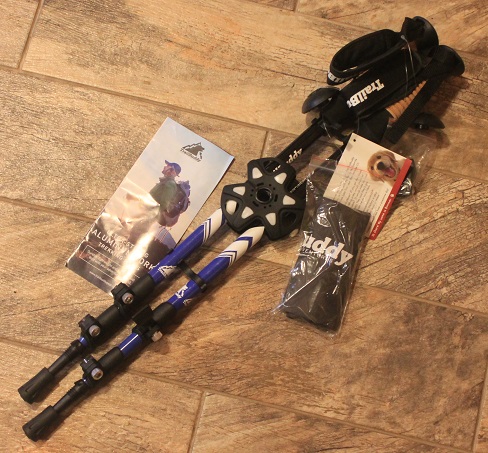
The new pair, when I pulled them out of their packet. They seem more sturdy than my older pair. Various tips are supplied with them, depending what you are walking on!
Backpack. One that will hold what you need it to hold. I will get a larger one next year, but this seems satisfactory overall for now. (This one was pre-existing for day hikes.) One added benefit: the hot tap water you carry down twice a day is nice and warm against your back, as noted again below! No, I don’t see the need to get an Appalachian Trail Thru-Hikers pack… But I will want one larger than the one I have now when I get more livestock – a subject to tackle physically (much) later on, though I am planning anyways. (I will also have vehicular access most days – a UTV or a small tractor.)
Gallon jug for water. I’ve re-purposed a Poland Springs gallon water jug for this purpose. The brand will matter – Poland Springs is one of the few brands that apparently has a screw top lid, and can be effectively re-sealed after each use. The plastic also seems a bit more sturdy than some other brands I’ve seen. Yes, I use tap water. I run the hot water tap and fill and re-fill the jug with it. Even when I get electric to the coop, I WILL HAVE to refill winter water daily, or twice daily, and very occasionally, thrice daily in winter, since the hose won’t run to the chickens in winter. Temperatures depending. The hose won’t be heated from the source sufficiently enough to keep this from freezing, considering the distance. Unless I want to spend buckets of money on this… One good thing about using hot tap water… in your backpack it really nicely keeps your backside warm on the way down and while you provide other chicken maintenance, prior to water dispensing! (Can’t mention this often enough!)
In case you are dubious about your own winter water (ie, oncoming storms and potential power failures) have a good stock of drinking water available for both yourself and them. I try not to deplete groceries of pre-bottled water – if I plan ahead, I can find plenty of food-safe containers in the house, and when I absolutely do have to buy some, I save those containers, for needs such as this.
(I admit I am also considering a second well, but… We, and the budget, shall see how this plays out, but it should be do-able for my future four-leggeds.)
Pans for water down at the coop. I started by using smaller kitty litter pans (virgin, of course – besides my cats would never keep their bizness inside a small kitty litter pan, anyway). Unfortunately, at very low temperatures (one demolished itself at 17 degrees F / minus 8.3 C), these pans have a habit of cracking when you try to remove ice so you can add more water. Nipple buckets and standard hanging buckets will freeze at the ports of exit for drinking, and while excellent in non-freezing seasons, aren’t optimal for those of us who get Real Winter. At any rate, I’ve just ordered a couple of 4.75 inch deep pans that are meant for research laboratory use, that are capable of holding frozen dry ice as well as liquid nitrogen (BRRRR!), these pans should not crack at any temperature on this planet where anyone is going to be apt to be raising chickens. (Yes, I’ve learned from my past scientific research life – they really do stand up to liquid nitrogen temps.) They cost quite a bit more, but. Done. On order, and on the way. I’ll edit this post to add a photo when they DO arrive. EDIT Jan 31st: I’m removing the recommendation for this product. Appearances online can sometimes be deceiving. When I get what I really was hoping to get, I will re-edit again, with that promised photo up close! PS, for $30 dollars one should not get glorified Styrofoam – yes it would hold liquid nitrogen, but for slamming ice out of it to replenish… not so good.
Large jug for food transport. I’ve re-purposed a plastic container once containing kitty litter for this. It holds more than the water jug, but won’t be as heavy, since it’s not carrying water, when full. It is severely better than manhandling 25 pounds of chicken feed to them at a time on icy surfaces. (Note my aforementioned knees and ankle, please.) I would not use this for water, as it is probably not food-safe plastic. I will bring down loads of food in the jug at one time, and store the food in the bin associated with the run, and return the empty container to my house until I need it again around a week later. (The only critters who have ever gotten into the bin have been crickets. Um, I do recycle those to the chickens! Crickets are dumb enough to be caught, but you won’t find them past September.) Note, if the ground isn’t slippery, I just manhandle down the 25 lb bag, or put half in a bucket that I use for storage in the bin and carry that down. Non-winter or muddy months, I just drive the stuff down, but I need a tractor or UTV for further farm growth! (THIS year…)
Egg collection apron. For 1-4 eggs, I can carry them in my jacket pockets, especially if I remembered to bring a few sheets of paper towel along. Both as buffer, and as a way when some eggs were dirty… my pockets could survive the mud or poo. This helped for the first month of what was winter up here. I’ve eleven hens, some of whom didn’t get the memo about not laying much in the darker days of the year… So, I got myself this egg collection apron. These seem to hold 12 eggs total (and there are still always your jacket pockets anyway for back up). With 11 hens, I certainly don’t need more than 12 pockets!
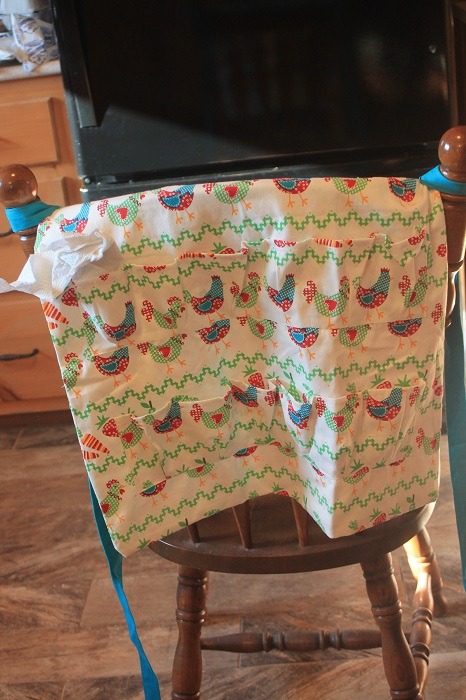
Winter apron, 12 slots for 12 eggs, none have dropped out when I bend over, to date. Safe also when I did a “slip and fall” in the snow, which fortunately damaged nothing more than my dignity. Paper towel (hard to see) to upper left is divvied out for dirty eggs, so I don’t have to wash this apron as often.
Yes, there are some great baskets for egg collection, but for winter with certain types of snow/ice/mud, I want my hands on my hiking poles. Sometimes I am bringing things back and forth leaving me with just the right-hand pole, but for everyday use? Give me a good apron! If I’ve slipped on my dignity, it’s been my backside! Cackleberry Home Egg Collecting & Gathering Apron 12 Pockets, Bright Garden (Amazon). They do have other apron patterns, but this one was chicken-themed.
Paper towels/face cloths. Nice to have, I keep them in my jacket pockets. They are also fine in the back pack. If you only have a couple or so of eggs each time, you can separate them from clinking against each other with a paper towel. Or a face cloth, which is more bulky. Your choice. (Face cloths are too bulky to fit with an egg into those apron slots.) Wrapping them also keeps poo’d -on eggs from contaminating the others or your apron slots, within reason. You may also want to store extra paper towels or face cloths in your chicken storage bin.
Snow shovel. Get an extra that you keep AT your coop/run. You don’t want the ability to access your coop or run to be ruined by snow that turns into frozen nastiness. Go out early and often, clear your entryways to the coop and run. I like the ergonomic shape, do as you will. On the small scale this clearing is, ergonomic need not be a consideration and a regular straight pole for a handle should do just fine, but I had an extra ergonomic one, so that’s what’s there.
Broom. I’m using the broom I also use to sweep out the coop. I also use it to brush off the top of the storage bin… turns out too much snow weight on the lid makes the hydraulic mechanism that keeps the bin open when I’m poking around in there, not work so well. Not crazy about the lid crashing down on my head, despite my winter head gear! The coop broom I use is has a 12-15 inch sweep, which for its main purpose (cleaning out the coop proper), is why I bought that size. It works with snow as well as with coop clean out. You may well find other uses… knock that snow that is turning into icicles off the coop roof, that sort of thing.
De-icing spray. This is the thing you keep around for your car lock especially back in the day when cars had to be opened with a manual key. This spray/spritzer is handy for getting into your coop if icing occurs. Even if icing occurs, you won’t always need it, but GOOD to have on hand, just in case. Or you could do what I had to do about twenty years ago to my car sitting in my driveway to get into it so I could get to work one morning after the entire driver side (and passenger side) doorway was iced over… a half liter of vodka… Yep, don’t laugh, although that car probably should have been pulled over for its own severe inebriation.
Head Lamp. This is something you should have anyway. Winter, summer, spring, fall. Chickens, four-legged livestock, getting lost in the woods, checking the outdoors for whatever, or just for anything! The back of my house does have lights, but you will want directed light, and why tie up the use of one arm in the dark holding a flashlight, lantern, or your truly awkward mobile phone to light your way? If you really have to go visit your chickens at night, it’s usually something you’ll want quick directed light to access. Full moonlight is cool, but hardly ever around when you need it. Also, it may not be good enough.
The head lamp I bought, Atomic Beam, is awesome. It uses LED lighting, and you can set the light to either of two levels of brightness (I’m sure the lower level will go through the battery slower), as well as to a strobe light, for which I’m not certain how I’d use that feature, but others may certainly find applications. Hopefully not for the induction of epilepsy, but if you are susceptible, I can see where this setting would be a trigger. There are straps so you can adjust it to fit your bare head, or over whatever winter or hard-hat needs you may have.
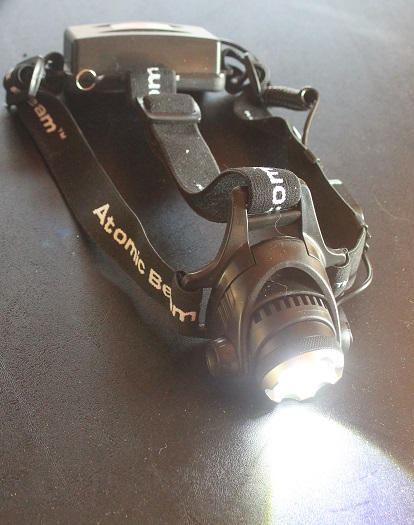
This is the beam on the lower intensity setting, simply so I could get a better photo. Love it!!!
I am planning on buying a second one to keep in the car. Just in case. Y’ never know! Atomic Beam Headlight by BulbHead, 5,000 Lux Hands-Free LED Headlamp, 3 Beam Modes (Amazon).
Yes, keep a stash of extra batteries for anything you might ever need to use that requires them!
Footprints: Especially if you are on a slope of any nature, and need to access your chickens or any other livestock on a regular basis, having defined footprints in your landscape can be a lifesaver. Back in the day around 20 or so years ago, when I only had ONE bad knee, I lived in a home atop a super-steep driveway, and if my car couldn’t climb up (it could have been plowed, but if it were icy, I still couldn’t always drive up…), I parked at the bottom, and hiked up the side of the drive. I left footprints and followed them both directions. I didn’t have hiking poles then, but had a couple good sturdy wood sticks (aka tree branches), and they kept me from falling. One day that 20-year-ago winter it suddenly reached 50+ degrees F, rained, and froze solid to 20 degrees F… and for the next five days the weather dropped to about 9 degrees F. Stayed there. I had to use those footprints, and those sticks, to get back and forth from my house to the car (and work) and back again. I remember the only thing I could purchase and get into my house during that time was canned cat food for my feline companions, because I could carry them in my pockets. (I lacked a backpack then.) Fortunately, I had plenty of human food there. So… hey, I maintain footprints as a fail-safe. And a backpack. Unless you can plow the area (and on a steep driveway, even that local plow could not make it non-icy and safe that week, and at that level of cold, salt just sits there and laughs at you), maintain a set of footprints.
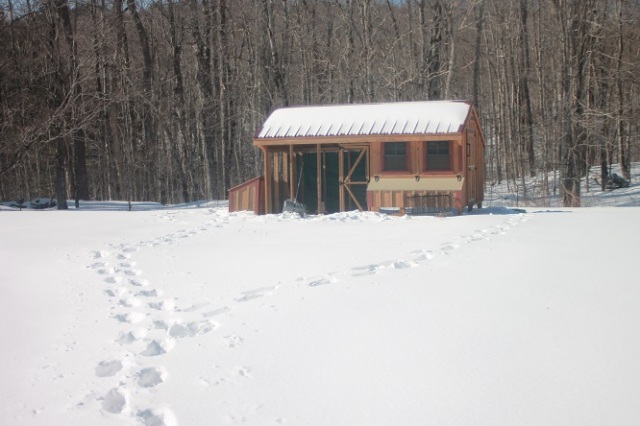
While this picture doesn’t demonstrate the slight slope I have, there is one, and those footprints can be awesome to follow, especially at the slope. In this photo, to the left they lead to the food bin, to the right to the coop itself. A shovel near the run door. The run is dark in back because I’ve tarped that area to keep excess winds and snow out.
Yes, you can plow out a path, but DO keep tracks for yourself so as not to slip. Because, as noted above… snow plow paths do NOT necessarily keep you safe from secure footsteps, even if there is any sort of slope involved. I KNOW this.
Boot or shoe crampons. Yaktracks is the popular brand, but Unigear traction cleats dig into ice even further. Choose your brand depending on your needs, and on the access you have to your coop. I’ve had a broken knee, and another knee where a benign tumor was removed the year prior to this, and a really bad ankle that now has pins and a plate. I’m working on trying to figure out how my XL-sized Unigear will fit with support on a hiking BOOT, rather than just the running shoes you see in these pics. (I wear 10.5 sized footwear… men’s, US sizing, although my boots are size 11.) Unigear Traction Cleats Ice Snow Grips with 18 Spikes for Walking, Jogging, Climbing and Hiking (Amazon).

With my seriously bad knees, I am best off if I can hoist myself off in this footwear, by going up from a chair. The backpack contains water, and can also contain other supplies as needed. The crampon-adapted shoes have spikes that are best not worn indoors, or on the epoxy surface of my chicken coop.
At any rate, you shouldn’t need to wear these every trip you take to the coop in winter.

Here’s a slippery slope, overly crunchy occasion… IN this case, we had a load of snow, then lots of rain but not everything melted away… and the residue rain settled into the remaining snow… Temperature plummet… ICE! This was seriously worse the day prior to the photo.
Here’s the spikey base of the cleats I am using. Step down solid as you walk.
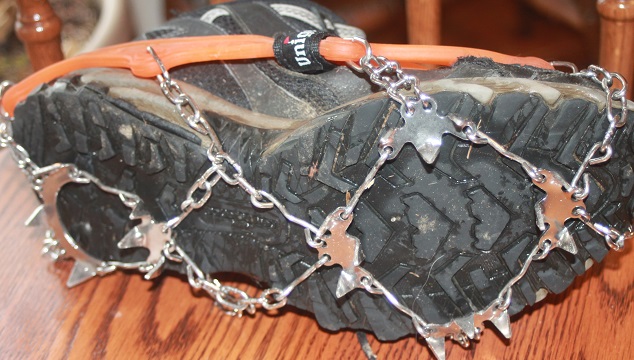
The spikes dig in somewhere between a quarter inch to a half an inch.
Winter garb. You should already know what works for you. I do try to keep two pairs of gloves, one regular winter wear for the cold, and another pair that I can switch to, which has more finger flexibility but protective capability should a chicken, especially a rooster, object to a procedure. Hopefully said procedures won’t be necessary, but one never knows.
One reminder: On really bright sunny days with snow on the ground, “snow blindness” is a thing. Get shades. Prescription, if needed. Or simply something to cover over glasses you may already need to have.
We’ve had three-four days to date where temps dropped to about 0 degrees F. I kept the chickens cooped up in their coop. They are able to keep each other warm, and if you have winter-hardy birds and have a properly-ventilated coop you should do just fine. You’ll need to provide them with liquid water more frequently, but that’s fine. Add ample pine shaving or hay bedding, and allow the poop by the roosts to accumulate… this will provide more warmth. But if it smells bad when you go in there, it means your ventilation system is inadequate or overloaded, and you will need to remove some of their droppings.
I understand that some breeds of chickens who are otherwise winter-hardy may be susceptible to comb or wattle frostbite. I understand that Vaseline rubbed on their combs will protect them from said frostbite. Fortunately, my Wyandotte roo, Tiny Dancer, is likely not susceptible — which is good, because I don’t think he’d stand still for frequent applications of the stuff.
Winter Garb Addendum, for -10 F and Worse:
January 19th through most of the 20th we had a snowfall of about a foot here. Then, late Sunday (the 20th) our temps just simply plummeted, to a low of -13 F / -25 C on Monday. Temperatures struggled up to about -7 by the end of that day. Wind chill factors hovered around minus 25 to minus 30 (probably lower here) all day. The 12 chickens were fine enclosed in their coop (no wind chill, decent ventilation, shared body warmth, some poop warmth, and I’d given them a third of a bag of extra pine shavings before the storm). Their water froze, but that’s why I had to go down and replenish.
Normally, a good pair of thermal gloves suffices. Mittens are hard to work with, and for certain tasks you WILL have to remove at least one of them for dexterity purposes. BUT, if you get winter weather this cold, BUY A PAIR of thermal MITTENS! You can remove one quickly if you need to have fingers at the ready for half a minute. Most times, warmer weather, thermal gloves will suffice.
But, best yet!!! My friend Kat just sent me information about two styles of convertible mittens/fingerless gloves. They seal up as mittens, and unseal to bring your fingers to the ready when briefly so needed – for instance, the picking up of eggs. I am ordering NOW. My choices: TrailHeads Power Stretch Convertible Mittens – Women’s Fingerless Gloves or Beurlike Women’s Winter Gloves Warm Wool Knitted Convertible Fingerless Mittens (both Amazon).
I was only down there about 15 minutes or so, but on the way back, I could feel my gloved fingers growing numb. I will also get a heavier-duty insulated hat (make sure any hat you have covers your ears, which mine did, but it was not heavy duty enough…). By the time I got back to the house, I was feeling that unpleasant “brain freeze” you can get if you eat too big a spoonful of really cold ice cream all at once.
I will also note that those effective temperatures around minus 30 F / minus 35 C wind chill factors will exhaust you. Wind out of one’s sails, and other metaphors… Or maybe it’s just me, at age 65? A good scarf and/or ski mask may also be in order.
Keep a stash of Vaseline or similar around in case a rooster or hen needs the protection from frostbite. (ATM, mine seem to be fine; as noted my rooster, Tiny Dancer, resists handling, so I’m glad he doesn’t need it. Some breeds are more susceptible than others to frostbite. In this region, I’d made a point of choosing breeds that were not.)
Upcoming Project
A friend convinced me not to sell my childhood sled on Craig’s List. Several years ago, rather tongue-in-cheek, I named it Rosebud, and while I do have fond memories using it as a child, I’m not into any Orson Wells state of attachment. I want to adapt it to my needs as a livestock keeper, and I figure something like setting it up for running bedding to my chickens would be a good first project. Bedding is just not something that will efficiently be run down to a coop using a back pack. Bedding is reasonably light, but it IS bulky. Whatever bedding you can carry in a back pack is not likely to do diddly in itself.
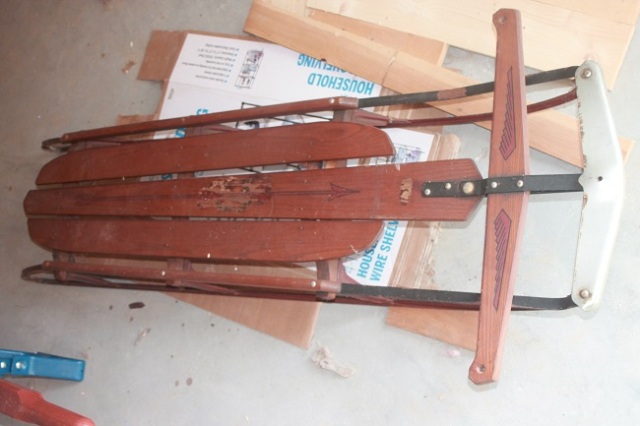
An ancient Fearless Flyer (late 50s, early 60s?), needs rope replacement, and one nut/bolt assembly also needs replacement. Otherwise, this will work fine for a downhill chicken bedding run, with proper bungee cords. Haven’t had the need yet, but I do have the rope and should simply just set it up! PS: Ancient memory of freezing my lip to the metal bar in front as a kid! Finally solved THAT problem via saliva!
Before that pre-T-Day snow storm hit (which was a predicted blizzard), I’d loaded up their bin with much of the stuff the chickens might need long term, including bedding. So, I have had time to adapt the sled.
So, here we go with Rosebud, keeping in mind that a manual old-fashioned sled such as this is, will not be practical in all snow conditions. Try to get anything you want to cart down that would work on a sled down there before you need to think about using a sled… because, yeah, one will not work in all winter conditions. Even if, as with me, you are transporting downhill. Consider this item a backup that will not always be useful, but if and when it is… It’s there!
At any rate: Don’t let Ole Man Winter get you DOWN!
Past Posts in this Series:
- Raising Chickens Part I: Intro & Overview
- Raising Chickens Part II: Welcoming Baby Chicks
- Raising Chickens Part III: Trekking to My Chickens in Zone 5 Winter
- Raising Chickens Part IV: My Chicken Run and Coop
- Raising Chickens Part V: The Bin, or Storage at Your Coop
- Raising Chickens Part VI: Feeding Those Layers
- Raising Chickens Part VII: Predation!
- Raising Chickens Part VIII: Is Organic the Way to Go?
Future Posts:
- Medical supplies and treatments for your chickens.
- Broody or Not?
- Recommended book, magazine and online sources for chicken learning!
Follow my Homesteading Page for 2019 updates as things happen here! Unfortunately, you won’t get notifications whenever I add a new date/addendum to that, so if you get a notification from the blog itself, do drop in to see. (PS I’d love conversation there, too.)
This post is shivering, but warming up over at Fiesta Friday, where this week’s co-hosts are Antonia @ Zoale.com and Julianna @ Foodie on Board.
Warming up, but still needing additional warmth, over at the Homestead Blog Hop!



 Sea Vegetable
Sea Vegetable
Wow! I am impressed. Living in zone 9 I had no idea how much trouble you need to go through in the winter.
Fortunately not ALL of winter. Just enough to make it a true annoyance. Today, for instance, it’s back down to minus 10 F. But next week it may reach 40! (Major clean-out on the schedule….)
Fantastic post and I LOVE that you tell it like it is from experience – that’s the kind of info ppl actually need! I admire you even more knowing you’re 65 and have issues! I’m out a lot usually with Chance (my deplorable labradorable) and the foot print thing is something I discovered, too! Also mittens do keep hands warmer than gloves. You might want to consider putting up sturdy poles with ropes or chains in the steepest/iciest areas next summer. Deeply embedded in cement below the frost line. Or even tie off a rope somewhere for now. Or get a snowmobile, lol! But that will only help sometimes, right. I get by with ski poles from the 2nd hand store but they don’t have all those tips. And have you thought about one of those saucers that the kids use for sleds? You could drill holes to tie down your bedding with large bungee cords or use one of those bungie type nets and drill holes for rope to haul. They might not last forever but they’re cheap and you could pick up several when winter dwindles for a song. I worked outside for several years in MN winters and swear by Sorel boots, when I didn’t need a heal for ladder climbing or poles, and Timberlake when I did, but you HAVE to use men’s boots, which was hard for me to find but will be easier for you. The women’s boots even if they look the same are cheaper and not as good (like so many things) and you need to get Sorels at a tractor supply or farm supply type place. They do have them at walmart/target type places but you are not likely to find the heavy duty ones there. Some are fancier and just for getting around and others are heavy duty! They are pricey and worth every penny! I also swear by the mad bomber hats! And udder cream or butt cream for your hands!
Wish I could taste just one of your fresh eggs!!
Wow, lots of information here! Thanks! I plan to have something next year in place for the steepest area of slope, a simple railing (rope or otherwise) will do. The saucers kids use for sleds… that would work nicely for bringing down poultry bedding. As far as men’s boots, I have to use them anyway… ladies sizes aren’t found for my not-so-dainty feet! I’ve noticed that jackets for hefty outdoor use are both less expensive and more hardy if you get the men’s… even though I can find women’s jackets in my size. Mad bomber hats… going to have to find them. Snowmobile may be a useful vehicle for winter to supplement the tractor/UTV I also plan to get – so things to be looking for in the near future. Thanks for your response!
It was a long reply – I get a little carried away sometimes, but such a great post!!
No problem, glad you got carried away!
You are so very dedicated: to your chickens and to your blog! This is a great post with so many details, that I am awed! On behalf of everyone at Fiesta Friday, I thank you!
Thanks… the chickens can be a pain (not them, just the weather) but the eggs are really worth it. And will be more worth it once the chickens can forage again.
I have really enjoyed your chicken series! What you go through, but there is nothing like fresh eggs! This is so interesting! Thank you for sharing at Fiesta Friday! Happy Fiesta Friday!
Thanks, Antonia. Only three eggs today… but they’ll catch up.
First of all, kudos and massive amounts of respect. To put on all that kit for what should be a simple and pleasant stroll out to the coop is monumental. Seriously, you have my respect.
Our run and coop are about 200 feet from the front door, and though I’ve been know to get out there in the freezing weather to take care of our lovelies, I usually have the kids do it.
Maybe I should rethink that strategy… we’re 5a/b.
Cheers!
Thanks. It does become challenging when sub zero. It is also challenging when everything melts here periodically and becomes MUD. But at least now a good Plus 24 degrees feels almost balmy these days!
For years I keep complaining that I can’t keep chickens in my backyard (zoning issue), but now I’m not so sure I’m up for it, lol. So much work, Diann! But those eggs are worth it, though, right? Btw, I used to have a rooster pet when I was little 😀
Yes, the eggs are really, really worth it! They’ll be even better when the ladies can get out and forage!
Oh… do tell me more about your pet rooster!
One day maybe I’ll write a post about it 😄 Crazy rooster, that’s all I can say for now. The dogs were actually scared of it! 😂
I understand roosters can be scary. Mine doesn’t warm to me, but he isn’t nasty, either. I hope to see that post sometime!
Pingback: Raising Chickens Part IV: My Chicken Coop and Run | Of Goats and Greens
Pingback: Raising Chickens, Part V: The Bin, or Storage at Your Coop | Of Goats and Greens
Pingback: Raising Chickens Part VI: Feeding Those Layers | Of Goats and Greens
Pingback: Raising Chickens, Part II: Welcoming Baby Chicks | Of Goats and Greens
Pingback: Raising Chickens, Part I (Intro & Overview) | Of Goats and Greens
Pingback: Raising Chickens, Part VII: Predation! | Of Goats and Greens
Pingback: Raising Chickens, Part VIII: Is Organic the Way to Go? | Of Goats and Greens